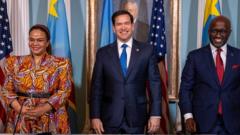Will the New Peace Deal Between DR Congo and Rwanda Finally Bring Stability?

Overview of the Peace Deal Between Rwanda and the Democratic Republic of Congo
The recent peace deal signed between Rwanda and the Democratic Republic of Congo (DRC) in Washington has generated significant interest and speculation. As both nations strive to end decades of conflict, this agreement emerges amidst a backdrop of violence, territorial disputes, and accusations of foreign military involvement. The implications of this deal are vast, not only for the two countries involved but also for the United States, which stands to gain access to valuable mineral resources in the DRC. Yet, as with many peace agreements in the region, skepticism remains regarding the likelihood of lasting peace.
The Context of the Conflict
The conflict between Rwanda and the DRC has deep historical roots, often linked to the aftermath of the Rwandan genocide in 1994. The spillover of this tragedy has led to a cycle of violence that has persisted for decades, with various armed groups vying for control in the eastern regions of the DRC. Among these groups, the M23 rebels have recently made headlines for their aggressive territorial expansions, including the capture of Goma and Bukavu.
The humanitarian toll of this ongoing conflict has been staggering, with thousands dead and hundreds of thousands displaced. The DRC's rich mineral deposits, including coltan—an essential component in electronics—add another layer of complexity, as foreign interests seek to exploit these resources amidst the chaos.
Recent Escalations and International Involvement
In early 2023, the resurgence of the M23 rebels prompted the DRC government to seek assistance from international allies, particularly the United States. This led to discussions that culminated in the recent peace deal, which aims to facilitate the "disengagement, disarmament, and conditional integration" of armed groups in the region.
However, the deal's outcome hinges on the cooperation of various stakeholders, including the Rwandan government, which has been accused of backing the M23 rebels despite its denials. The accusations are compounded by Rwanda's concerns regarding the FDLR, a militia composed primarily of Hutus and linked to the Rwandan genocide.
Key Elements of the Peace Agreement
While the specifics of the peace agreement remain largely undisclosed, several key elements have emerged:
- Disengagement of Armed Groups: The agreement calls for the disengagement of various armed factions, with an emphasis on the M23 and FDLR.
- Conditional Integration: There are provisions for the conditional integration of some armed groups into the national military, contingent on the fulfillment of specific criteria.
- Return of Displaced Persons: The deal includes measures for facilitating the return of refugees and internally displaced individuals, a pressing humanitarian concern.
- Territorial Integrity: The agreement stresses the importance of respecting territorial integrity and prohibiting hostilities between the two nations.
Contentions and Challenges Ahead
Despite the hopeful framing of this agreement by leaders from both sides, significant challenges remain. The concept of "disengagement" versus "withdrawal" is a particularly contentious issue. Rwandan officials have firmly stated that the term "withdrawal" does not appear in the document, indicating a reluctance to commit to a full military withdrawal.
Additionally, the DRC's insistence on the immediate withdrawal of Rwandan troops has been met with resistance, creating a potential impasse that could threaten the agreement's viability. These differences highlight the delicate balance of interests that must be navigated to foster genuine peace.
The Role of the United States
The involvement of the United States in facilitating this peace deal underscores the geopolitical significance of the region. The DRC's vast mineral wealth presents lucrative opportunities for American companies, particularly in the tech sector, which relies heavily on minerals like coltan. The U.S. has positioned itself as a mediator and supporter of peace efforts, aiming to stabilize the region while safeguarding its economic interests.
President Donald Trump’s characterization of the deal as a "great day for Africa" reflects the U.S. administration's desire to be seen as a constructive force in global diplomacy. However, this raises questions about whether the motivations for peace are genuinely focused on humanitarian concerns or primarily driven by economic incentives.
Historical Precedents of Peace Agreements in the Region
The DRC and Rwanda are not strangers to peace deals; however, many past agreements have failed to bring about lasting stability. The 2007 peace agreement, for instance, aimed to address the root causes of conflict but ultimately fell short of its goals, leading to the resurgence of violence.
Lessons from these historical precedents highlight the need for robust verification mechanisms and a commitment from all parties to uphold their obligations. Without these safeguards, the current agreement risks becoming another chapter in a long history of unfulfilled promises.
The Importance of Regional Cooperation
For the peace deal to succeed, regional cooperation is essential. Both Rwanda and the DRC must engage with neighboring countries and international organizations to create a supportive environment for peace. This collaborative approach can enhance the legitimacy of the agreement and foster trust among stakeholders.
Moreover, addressing the concerns of local communities affected by the conflict is crucial. Empowering these communities to participate in the peace process can create a sense of ownership over the outcomes and foster more sustainable solutions.
Conclusion: A Path Forward or Another False Dawn?
The peace deal between Rwanda and the Democratic Republic of Congo represents a crucial opportunity to end a cycle of violence that has persisted for decades. However, the road ahead is fraught with challenges, and the success of this agreement will depend on the commitment of both nations to uphold their obligations and address the underlying issues that have fueled the conflict.
As the world watches, the unfolding events in the Great Lakes region will serve as a litmus test for international diplomacy and regional cooperation. The question remains: will this peace deal mark a turning point towards lasting stability, or will it be yet another false dawn in the quest for peace?
FAQs About the Peace Deal Between Rwanda and the Democratic Republic of Congo
What are the key elements of the Rwanda-DRC peace deal?
The peace deal includes the disengagement of armed groups, conditional integration of some factions into the national military, provisions for the return of displaced persons, and a commitment to respect territorial integrity.
Why is the role of the United States significant in this agreement?
The U.S. is seen as a mediator and supporter of the peace process, with interests in the DRC's mineral wealth. Its involvement emphasizes the geopolitical stakes of achieving stability in the region.
What challenges does the peace deal face?
Challenges include differing interpretations of troop withdrawal, the need for genuine regional cooperation, and the historical failure of past agreements to yield lasting peace.
As this situation unfolds, how do you envision the future of peace in the DRC and Rwanda? The implications of this agreement reach far beyond the borders of these two nations, impacting the entire region. #Rwanda #DRC #PeaceDeal
Published: 2025-06-27 17:32:11 | Category: technology



